Numerical Simulation Study on Mechanical Characteristics and Width Optimization of Narrow Coal Pillar in Gob-Side Coal Seam Tunnel
Abstract
:1. Introduction
2. Engineering Background
3. Experimental
3.1. Analysis of Stress Distribution in Narrow Coal Pillars
- The coal body is a homogeneous continuum.
- The coal strength is the highest in the case of the plain strain.
- The coal body damaged by shear effects is in accordance with the Mohr–Coulomb criterion [28].
3.2. Establishment of the Numerical Model
4. Results and Discussion
4.1. Vertical Stress Distribution
4.2. Horizontal Stress Distribution
- When the width of the NCP increased, the force at both ends of the NCP became more uniform. Therefore, the mean horizontal stress increased. In the NCP, the stress at the bottom was greater than the stress at the top, and the horizontal stress at the two ends was greater than intermediate horizontal stress.
- The horizontal stress of the NCP first decreased from the bottom to the top and then increased. In the NCP, from the bottom up to one-third of the NCP, horizontal stress alleviated linearly; from one-third to two-thirds length of the NCP, horizontal stress remained unchanged. From two-thirds up to the top, the horizontal stress tended to enhance linearly.
4.3. Vertical Displacement of the Roof of Adjoining Rock
4.4. Deformation Distribution of Narrow Coal Pillars in the Plastic Zone
5. Coal Pillars Stress and Deformation Analysis
5.1. Vertical Stress of the Coal Pillars for Various Widths
5.2. Horizontal Stress of Coal Pillars for Varying Widths
6. Case Study
6.1. Determining the Width of the Narrow Coal Pillars
6.2. Anchor Rod and Cable Stress Monitoring
6.3. Observation
7. Conclusions
- In the NCP of an inclined coal seam, the vertical stress increases first and then decreases, and the horizontal stress decreases first and then increases from bottom to top. With the rising of the NCP width, the peak values of vertical stress and horizontal stress increase in logarithmic function form. The quantitative relationship between pillar size and peak stress is obtained by fitting.
- Through the numerical simulation method, the relationship between the NCP width in an inclined coal seam and the stress distribution, the plastic zone distribution, and the peak stress are calculated, respectively. Combined with the measured values of the deformation and stress distribution of the adjoining rock, the optimal dimension mathematical model of the NCP is verified. Therefore, the optimal width of the NCP in the (4–5) 06 fully mechanized caving face is 4 m.
- The NCP of an inclined coal seam is in the form of oblique cutting failure, and it is necessary to strengthen the support of the roadway shoulder corner. The anchor rod and cable support system designed according to the theoretical and numerical calculation results can provide higher support strength and stiffness, which can effectively control the NCP from slipping to the inside of the roadway, prevent the serious deformation of NCP, meet the support requirements of adjoining rock of gob-side tunnel in (4–5) 06 working face, and ensure the overall stability of the roadway.
Author Contributions
Funding
Institutional Review Board Statement
Informed Consent Statement
Data Availability Statement
Conflicts of Interest
References
- Yuan, L. Research progress of mining response and disaster prevention and control in deep coal mine. J. China Coal Soc. 2021, 46, 716–725. (In Chinese) [Google Scholar]
- Xie, H.P.; Wang, J.H.; Wang, G.F.; Ren, H.W.; Liu, J.Z.; Ge, S.R.; Zhou, H.W.; Wu, G.; Ren, S. New ideas of coal revolution and layout of coal science and technology development. J. China Coal Soc. 2018, 43, 1187–1197. (In Chinese) [Google Scholar]
- Wang, J.; Jiang, J.Q.; Li, G.B.; Hu, H. Exploration and numerical analysis of failure characteristic of coal pillar under great mining height longwall influence. Geotech. Geol. Eng. 2016, 34, 689–702. [Google Scholar] [CrossRef]
- Liu, S.F.; Wan, Z.J.; Zhang, Y.; Lu, S.F.; Ta, X.P.; Wu, Z.P. Research on evaluation and control technology of coal pillar stability based on the fracture digitization method. Measurement 2020, 158, 107713. [Google Scholar] [CrossRef]
- Dai, J.J.; Shan, P.F.; Zhou, Q. Study on intelligent identification method of coal pillar stability in fully mechanized caving face of thick coal seam. Energies 2020, 13, 305. [Google Scholar] [CrossRef] [Green Version]
- Wu, H.; Wang, X.K.; Wang, W.J.; Peng, G.; Zhang, Z.Z. Deformation characteristics and mechanism of deep subsize coal pillar of the tilted stratum. Energy Sci. Eng. 2020, 8, 544–561. [Google Scholar] [CrossRef]
- Qi, J.D.; Chai, J.; Zhang, J.Z. Numerical simulation on stress distribution of the inclined coal seam under different pillar width. Adv. Mater. Res. 2014, 977, 374–377. [Google Scholar] [CrossRef]
- Jaiswal, A.; Shrivastva, B.K. Numerical simulation of coal pillar strength. Int. J. Rock Mech. Min. Sci. 2008, 46, 779–788. [Google Scholar] [CrossRef]
- Zhang, Z.Z.; Deng, M.; Wang, X.Y.; Yu, W.J.; Zhang, F.; Dao, V.D. Field and numerical investigations on the lower coal seam entry failure analysis under the remnant pillar. Eng. Fail. Anal. 2020, 115, 104638. [Google Scholar] [CrossRef]
- Wu, H.; Zhang, N.; Wang, W.J.; Zhao, Y.; Cao, P. Characteristics of deformation and stress distribution of small coal pillars under leading abutment pressure. Int. J. Min. Sci. Technol. 2015, 25, 921–926. [Google Scholar] [CrossRef]
- Wang, B.N.; Dang, F.N.; Gu, S.C.; Huang, R.B.; Miao, Y.P.; Chao, W. Method for determining the width of protective coal pillar in the pre-driven longwall recovery room considering main roof failure form. Int. J. Rock. Mech. Min. Sci. 2020, 130, 104340. [Google Scholar] [CrossRef]
- Yang, R.S.; Zhu, Y.; Li, Y.L.; Li, W.Y.; Lin, H. Coal pillar size design and surrounding rock control techniques in deep longwall entry. Arabian J. Geosci. 2020, 13, 453. [Google Scholar] [CrossRef]
- Bai, J.-B.; Shen, W.-L.; Guo, G.-L.; Wang, X.-Y.; Yu, Y. Roof deformation, failure characteristics, and preventive techniques of gob-side entry driving heading adjacent to the advancing working face. Rock Mech. Rock Eng. 2015, 48, 2447–2458. [Google Scholar] [CrossRef]
- Qi, F.Z.; Ma, Z.G.; Yang, D.W.; Li, N.; Li, B.; Wang, Z.L.; Ma, W.X. Stability control mechanism of high-stress roadway surrounding rock by roof fracturing and rock mass filling. Adv. Civil Eng. 2021, 2021, 317–334. [Google Scholar] [CrossRef]
- Zhao, Y.-M.; Feng, X.-T.; Jiang, Q.; Han, Y.; Zhou, Y.-Y.; Guo, H.-G.; Kou, Y.-Y.; Shi, Y.-E. Large deformation control of deep roadways in fractured hard rock based on cracking-restraint method. Rock Mech. Rock Eng. 2021, 54, 2559–2580. [Google Scholar] [CrossRef]
- Wu, X.-Y.; Jiang, L.-S.; Xu, X.-G.; Guo, T.; Zhang, P.-P.; Huang, W.-P. Numerical analysis of deformation and failure characteristics of deep roadway surrounding rock under static-dynamic coupling stress. J. Cent. South Univ. 2021, 28, 543–555. [Google Scholar] [CrossRef]
- Li, Z.L.; Wang, L.G.; Lu, Y.L.; Li, W.S.; Wang, K. Effect of principal stress rotation on the stability of a roadway constructed in half-coal-rock stratum and its control technology. Arabian J. Geosci. 2021, 14, 292–303. [Google Scholar] [CrossRef]
- Xu, B.; Li, Y.; Wang, S.; Lu, B. Study on the strength characteristics and failure characteristics of the composite load-bearing structure in the cemented filling field. Constr. Build. Mater. 2022, 330, 127242. [Google Scholar] [CrossRef]
- Ji, S.T.; Karlovšek, J. Calibration and uniqueness analysis of microparameters for DEM cohesive granular material. Int. J. Min. Sci. Technol. 2022, 32, 121–136. [Google Scholar] [CrossRef]
- Ji, S.T.; Karlovšek, J. Optimized differential evolution algorithm for solving DEM material calibration problem. Eng. Comput. 2022, 1–16. [Google Scholar] [CrossRef]
- Zhu, X.J.; Guo, G.L.; Liu, H.; Peng, X.; Yang, X.Y. Stability analysis of the composite support pillar in backfill-strip mining using particle flow simulation method. Environ. Earth Sci. 2022, 81, 124. [Google Scholar] [CrossRef]
- Fu, J.W.; Haeri, H.; Sarfarazi, V.; Babanouri, N.; Rezaei, A.; Manesh, M.O.; Bahrami, R.; Marji, M.F. Effects of axial loading width and immediate roof thickness on the failure mechanism of a notched roof in room and pillar mining: Experimental test and numerical simulation. Rock Mech. Rock Eng. 2022, 1–27. [Google Scholar] [CrossRef]
- Sarfarazi, V.; Abharian, S.; Ghorbani, A. Physical test and PFC modelling of rock pillar failure containing two neighboring joints and one hole. Smart Struct. Syst. 2021, 27, 123–137. [Google Scholar]
- Fan, N.; Wang, J.R.; Zhang, B. Reasonable width of segment pillar of fully-mechanized caving face in inclined extra-thick coal seam. Geotech. Geol. Eng. 2020, 38, 4189–4200. [Google Scholar] [CrossRef]
- Wang, Q.; Gao, H.K.; Jiang, B.; Li, S.; He, M.; Wang, D.; Lu, W.; Qin, Q.; Gao, S.; Yu, H.C. Research on reasonable coal pillar width of roadway driven along goaf in deep mine. Arabian J. Geosci. 2017, 10, 466–483. [Google Scholar] [CrossRef]
- Fan, L.; Wang, W.J.; Yuan, C.; Peng, W.Q. Research on large deformation mechanism of deep roadway with dynamic pressure. Energy Sci. Eng. 2020, 8, 3348–3364. [Google Scholar] [CrossRef]
- Zhang, Y.; Wan, Z.J.; Li, F.C.; Zhou, C.B.; Zhang, B.; Feng, G.; Chengtan, Z. Stability of coal pillar in gob-side entry driving under unstable overlying strata and its coupling support control technique. Int. J. Min. Sci. Technol. 2013, 23, 193–199. [Google Scholar] [CrossRef]
- Wojciechowski, W. A note on the differences between Drucker-Prager and Mohr-Coulomb shear strength criteria. Stud. Geotech. Mech. 2018, 40, 163–169. [Google Scholar] [CrossRef] [Green Version]
- Loboda, V.; Gerge, I.; Khodanen, T.; Mykhail, O. A crack between orthotropic materials with a shear yield zone at the crack tip. Math. Prob. Eng. 2019, 2019, 9723089. [Google Scholar] [CrossRef]
- Zhang, K.X.; Jiang, Y.D.; Zhang, Z.B. Determination of reasonable width of narrow coal pillars along goaf in large coal pillars. J. Min. Saf. Eng. 2014, 31, 255–262. (In Chinese) [Google Scholar]

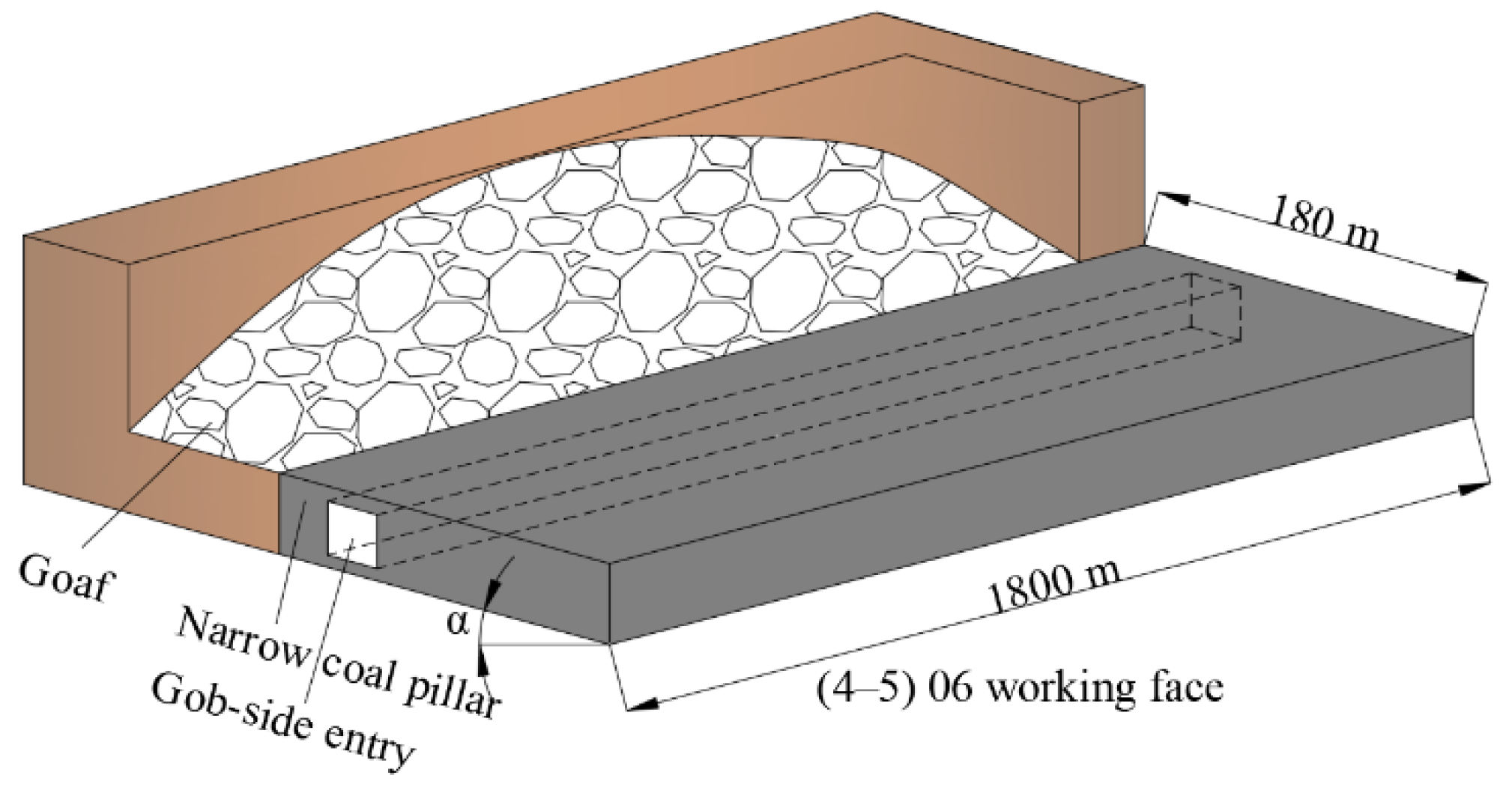


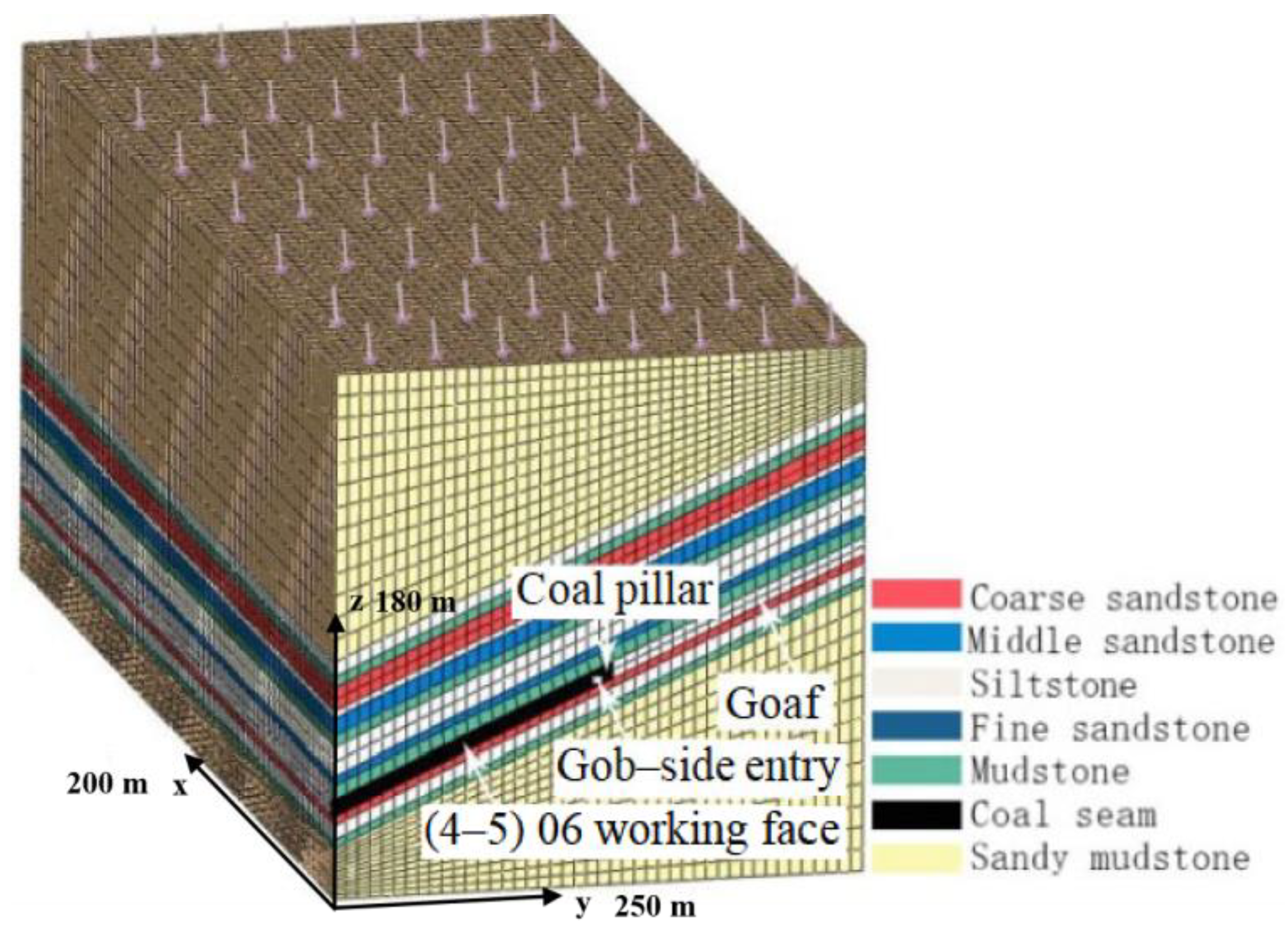




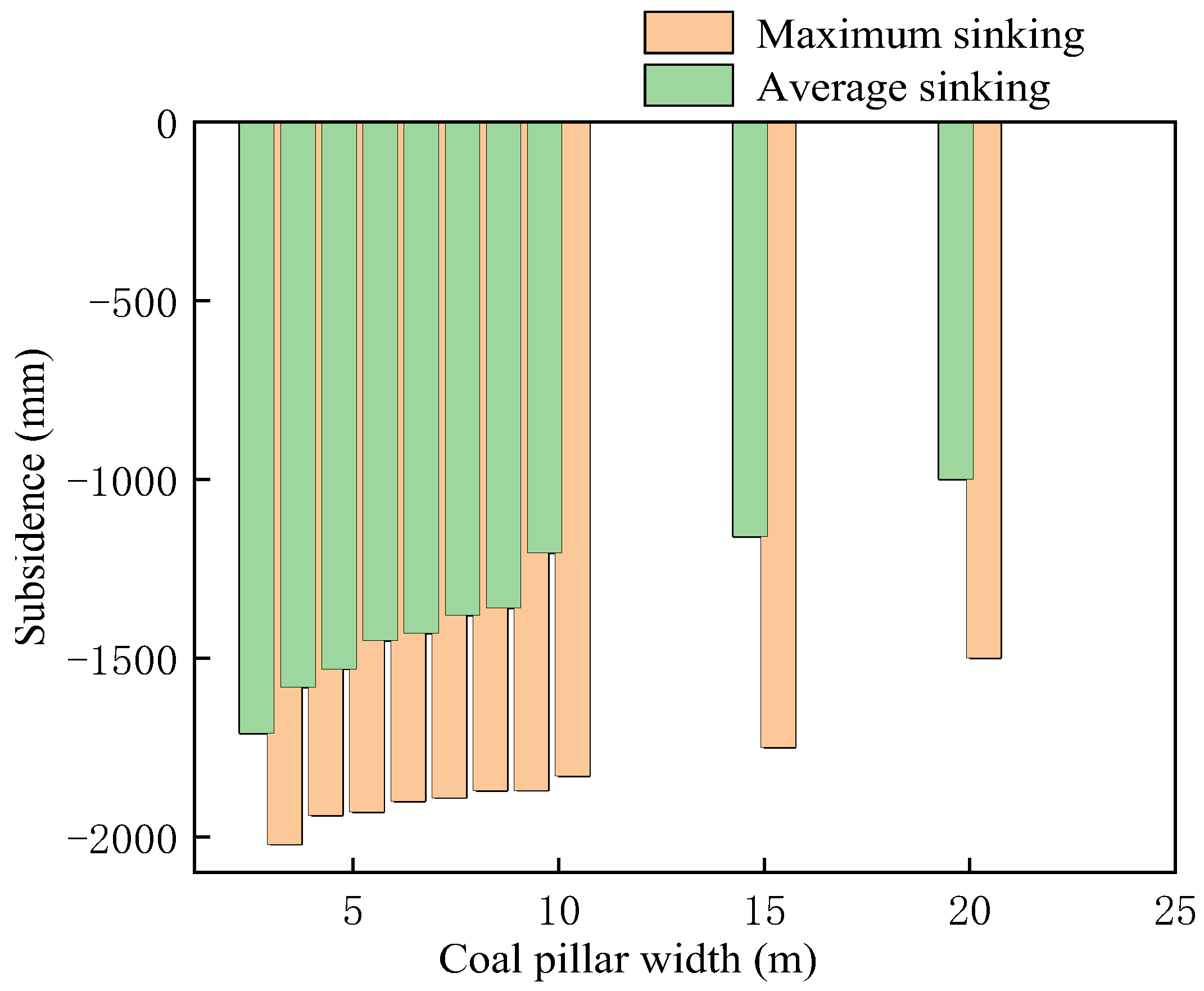
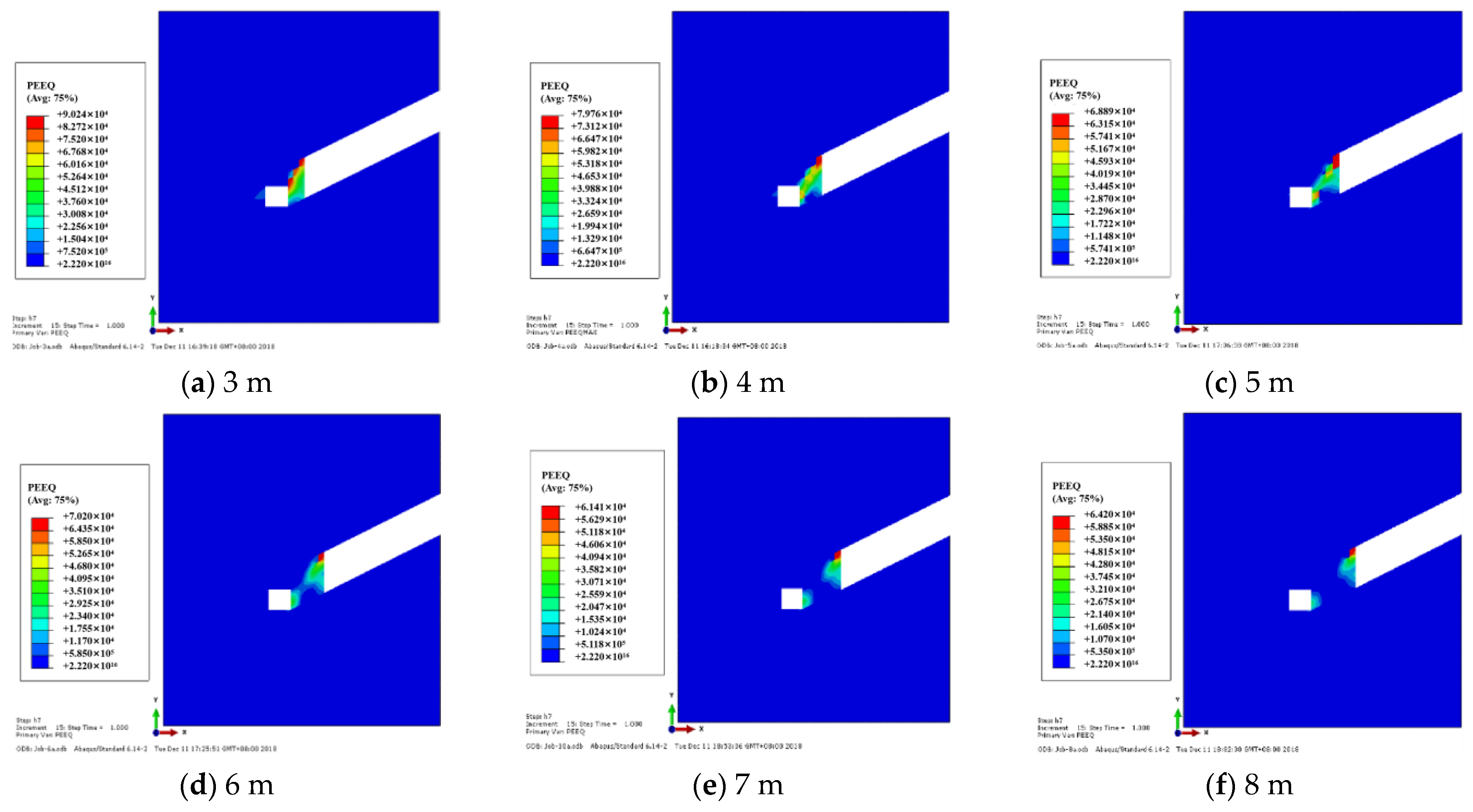
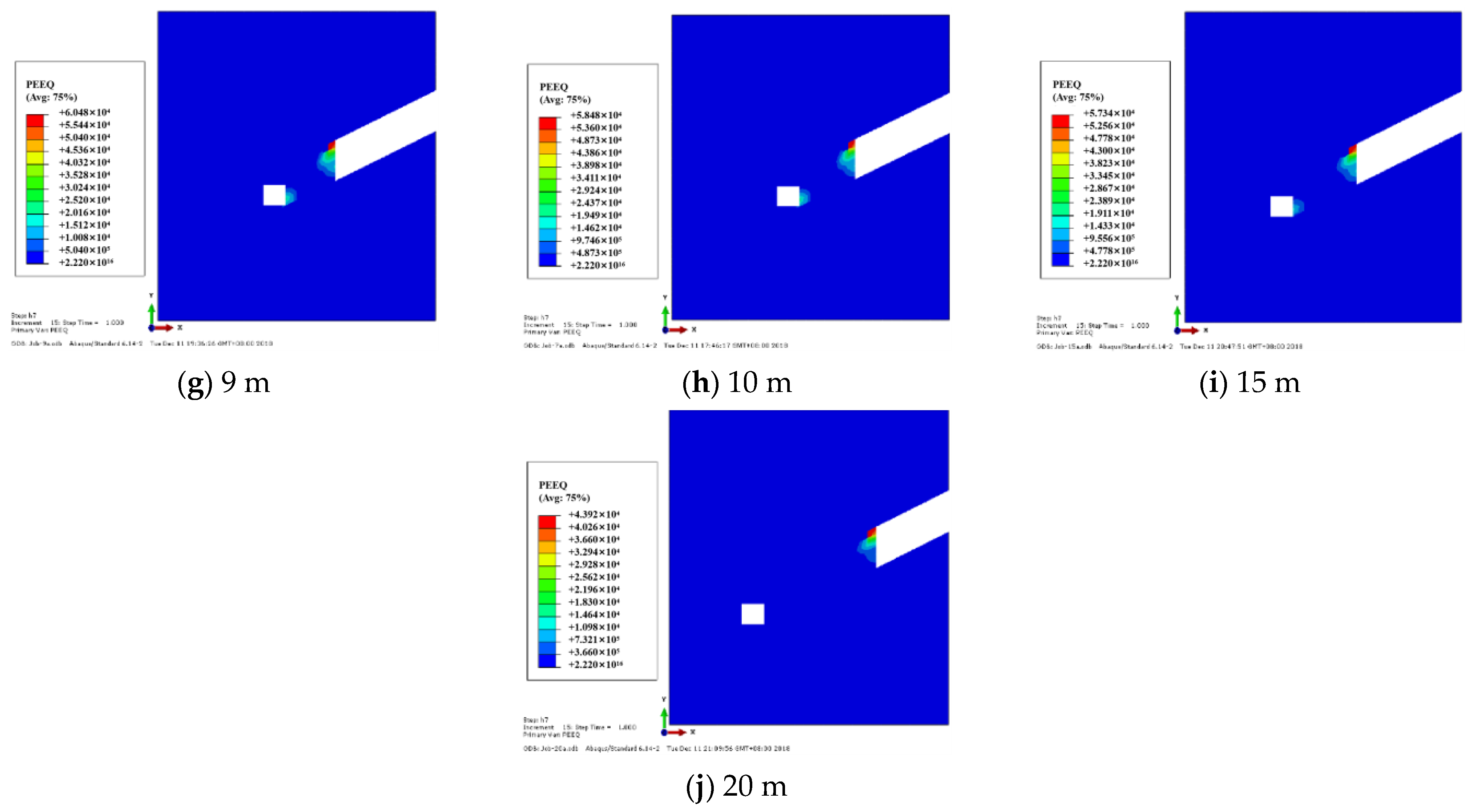
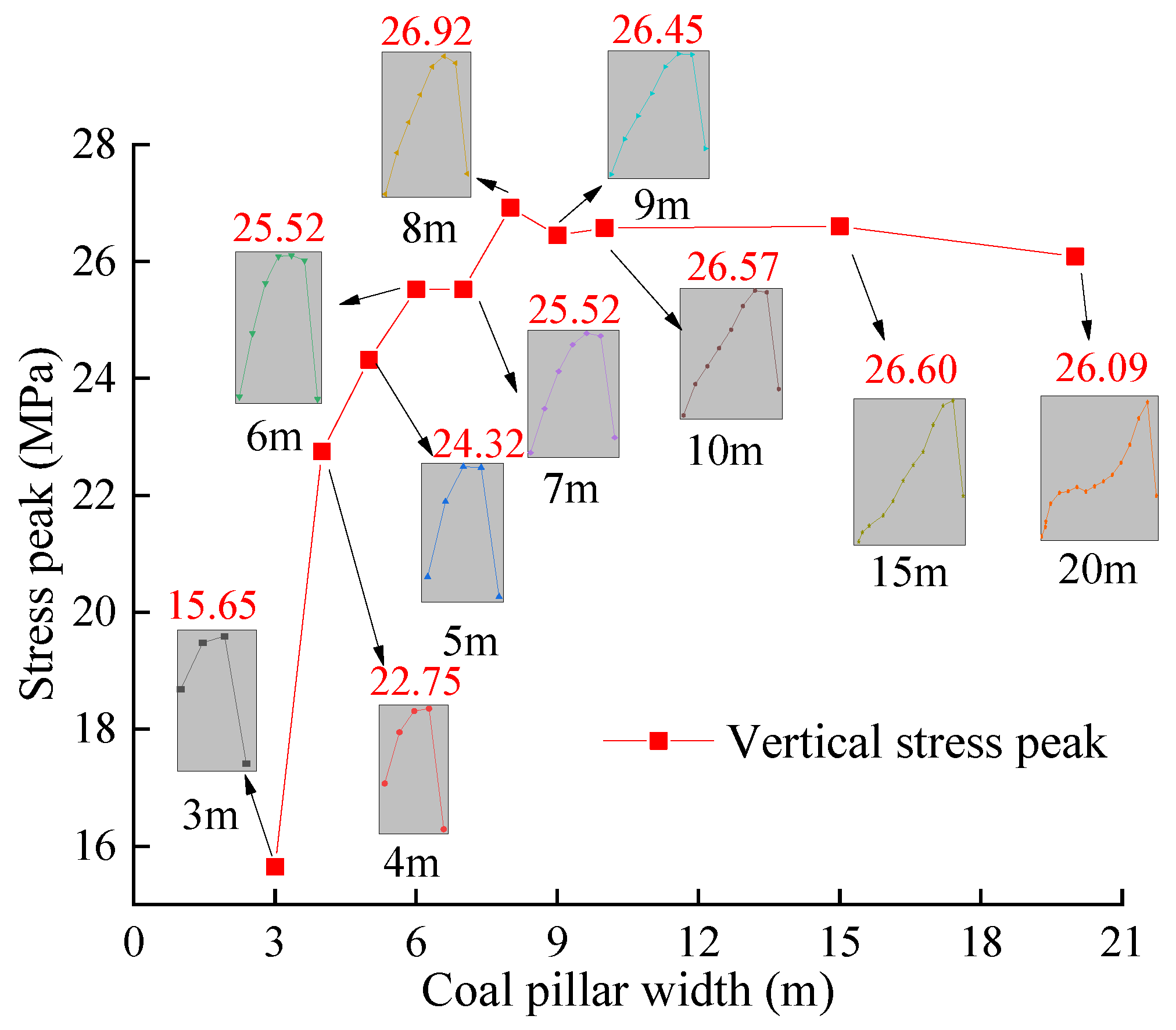

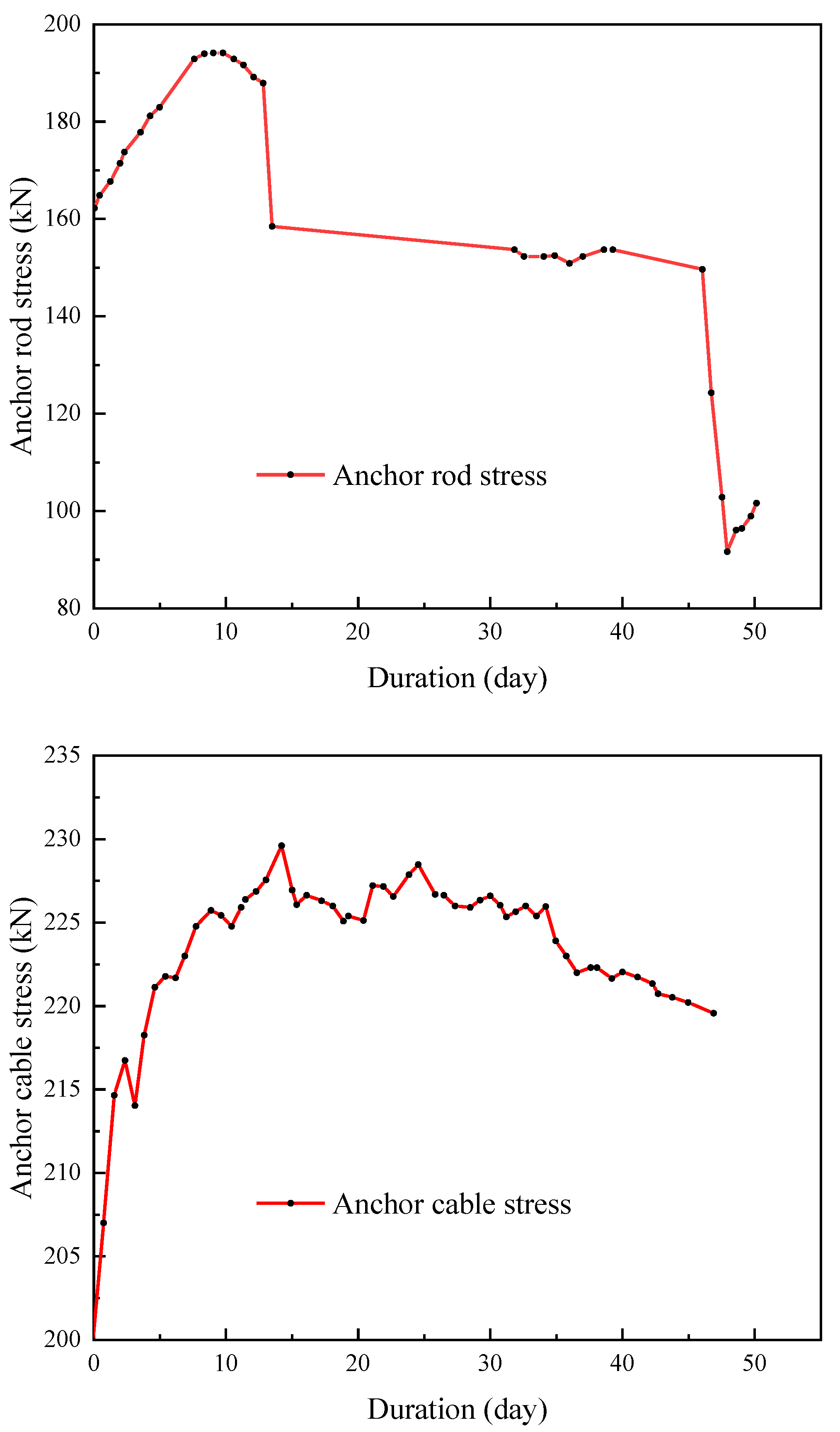

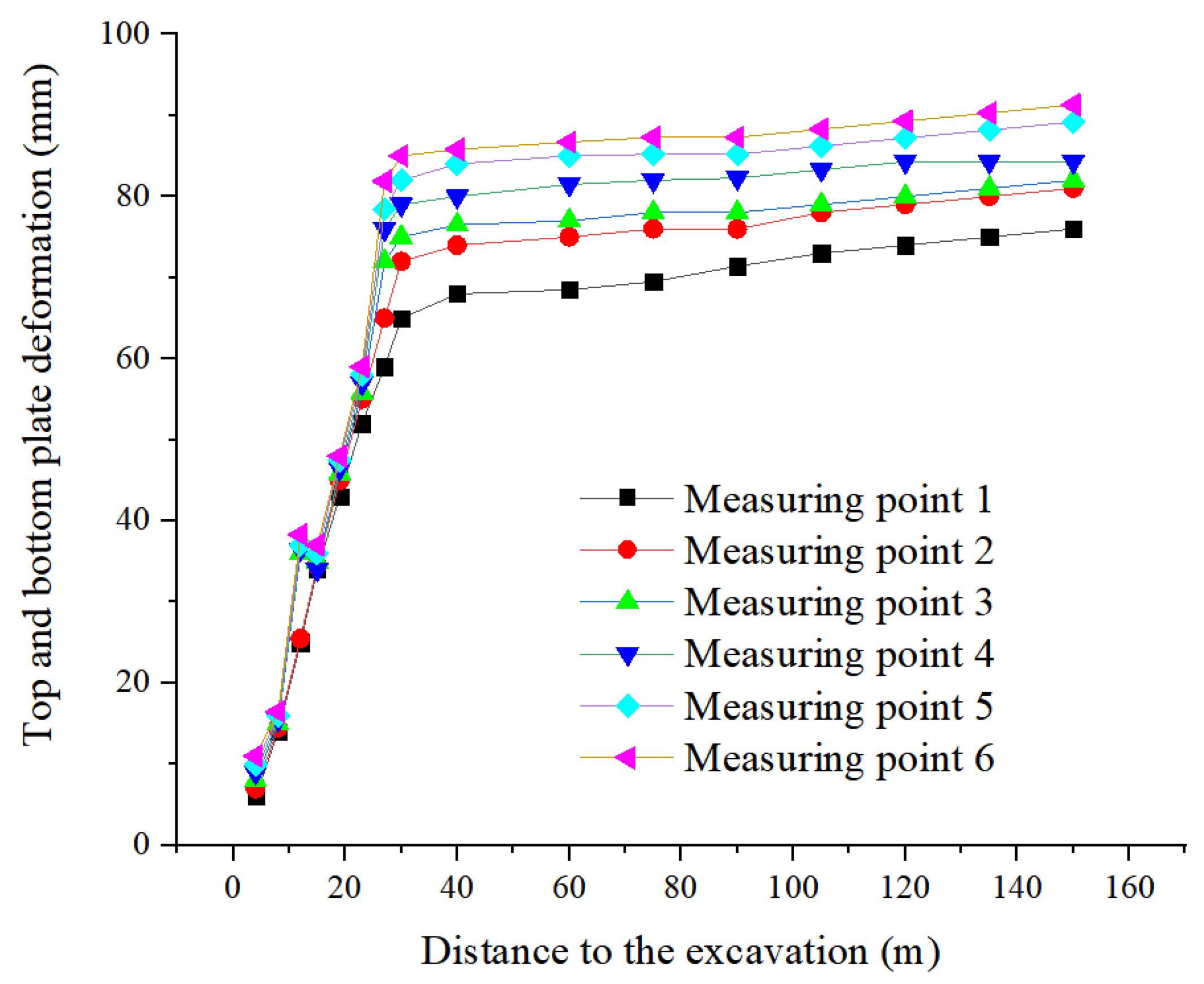
| Position | Lithology | γ (kN/m3) | E (MPa) | Poisson (p) | C0 (MPa) | Dilatancy Angle (°) | Internal Friction Angle (°) | Tensile Strength (MPa) |
|---|---|---|---|---|---|---|---|---|
| Roof | Mudstone | 20.8 | 20,019 | 0.19 | 0.93 | 8 | 31 | 0.67 |
| Middle sandstone | 26.6 | 50,430 | 0.28 | 2.27 | 10 | 31 | 0.85 | |
| Fine sandstone | 26.2 | 43,020 | 0.26 | 1.93 | 10 | 31 | 0.56 | |
| Siltstone | 20.0 | 34,739 | 0.25 | 1.3 | 12 | 35 | 0.87 | |
| Coal seam | Coal | 14.6 | 14,142 | 0.27 | 0.72 | 8 | 20 | 0.53 |
| Bottom plate | Coarse sandstone | 26.4 | 56,767 | 0.27 | 1.38 | 8 | 34 | 0.34 |
| Sandy mudstone | 26.4 | 56,767 | 0.27 | 1.38 | 8 | 34 | 0.34 |
| Selection | Type | Distance between Anchors (mm) | Diameter (mm) | Length (mm) | Resin Roll Anchoring |
|---|---|---|---|---|---|
| Anchors | KMG500 | 800 | 22 | 2200 | MSCK2370 |
| Anchor cables | KMG800 | 1600 | 22 | 7300 | MSCK2335 |
| Measuring Point | 1 | 2 | 3 | 4 | 5 | 6 |
|---|---|---|---|---|---|---|
| Distance from heading face (m) | 200 | 400 | 600 | 800 | 1000 | 1200 |
Publisher’s Note: MDPI stays neutral with regard to jurisdictional claims in published maps and institutional affiliations. |
© 2022 by the authors. Licensee MDPI, Basel, Switzerland. This article is an open access article distributed under the terms and conditions of the Creative Commons Attribution (CC BY) license (https://creativecommons.org/licenses/by/4.0/).
Share and Cite
Zhao, P.; Zhang, W.; Li, S.; Chang, Z.; Lu, Y.; Cao, C.; Shi, Y.; Jia, Y.; Lou, F.; Wei, Z.; et al. Numerical Simulation Study on Mechanical Characteristics and Width Optimization of Narrow Coal Pillar in Gob-Side Coal Seam Tunnel. Sustainability 2022, 14, 16014. https://doi.org/10.3390/su142316014
Zhao P, Zhang W, Li S, Chang Z, Lu Y, Cao C, Shi Y, Jia Y, Lou F, Wei Z, et al. Numerical Simulation Study on Mechanical Characteristics and Width Optimization of Narrow Coal Pillar in Gob-Side Coal Seam Tunnel. Sustainability. 2022; 14(23):16014. https://doi.org/10.3390/su142316014
Chicago/Turabian StyleZhao, Pengxiang, Wenjin Zhang, Shugang Li, Zechen Chang, Yajie Lu, Congying Cao, Yu Shi, Yongyong Jia, Fang Lou, Zongyong Wei, and et al. 2022. "Numerical Simulation Study on Mechanical Characteristics and Width Optimization of Narrow Coal Pillar in Gob-Side Coal Seam Tunnel" Sustainability 14, no. 23: 16014. https://doi.org/10.3390/su142316014






